| Cycas micronesica | |
|---|---|
.jpg.webp) | |
| Scientific classification | |
| Kingdom: | Plantae |
| Clade: | Tracheophytes |
| Clade: | Gymnospermae |
| Division: | Cycadophyta |
| Class: | Cycadopsida |
| Order: | Cycadales |
| Family: | Cycadaceae |
| Genus: | Cycas |
| Species: | C. micronesica |
| Binomial name | |
| Cycas micronesica K.D. Hill, 1994 | |
Cycas micronesica is a species of cycad found on the island of Yap in Micronesia, the Marianas islands of Guam and Rota, and The Republic of Palau. It is commonly known as federico nut or fadang in Chamorro. The species, previously lumped with Cycas rumphii and Cycas circinalis, was described in 1994 by Ken Hill.[2] Paleoecological studies have determined that C. micronesica has been present on the island of Guam for about 9,000 years.[3] It is linked with Lytico-Bodig disease, a condition similar to amyotrophic lateral sclerosis (ALS), due to the neurotoxin BMAA found in its seeds, which were a traditional food source on Guam until the 1960s.[4] The neurotoxin is present due to its symbiosis with cyanobacteria.[5][6]
Description
Cycas micronesica is a medium-sized tree most commonly 2–5 meters tall but can reach heights up to 15 meters. The tree has a straight palm like trunk ringed with frond scars.[7]
Leaves
Leaves are 140–180 cm long, flat in section (opposing pinnae inserted at 180 degrees on rhachis), with 130 -150 pinnae, terminated by a spine c. 4mm long; petiole usually glabrous, usually unarmed, rarely spinescent for up to 20% of length, 35 – 45 cm long; median pinnae at 70-80 degrees to rachis, 240 – 280 mm long, 16 –17 mm wide, 0.35 - 0.45 mm thick, glabrous, dull green or slightly bluish-green when developing, becoming glossy mid-green at maturity, flat in section with slightly recurved margins, strongly discolorous, decurrent for 7–10 mm, narrowed to 5.0-6.0 mm at base, 17 – 20 mm apart on rhachis apex attenuate; midrib not sharply raised, more or less equally prominent above and below, 1.2 -1.5 mm wide.[8]
Reproductive organs
Like all cycads, Cycas micronesica are dioecious. Females possess clusters of ovules situated on modified leaves called megasporophylls. Male reproductive structures consist of modified leaves called microsporophylls, but each modified leaf has small, compact pollen sacks attached to their lower surface.[9] There has been documentation of the symbiotic relationship the Guamanian C. micronesica with Anatrachyntis sp., which depends on male cones (microsporangia) for oviposition and recruitment in return for pollinating the species.
The microsporangiate cones are pale fawn to pale orange-brown, narrowly ovoid, 30–50 cm long, 8–10 cm in diameter. Microsporophyll lamina are 35–45 mm long, 20–25 mm wide; fertile zone 25–35 mm long; sterile apex 7–10 mm long, not recurved, apical spine somewhat reduced, broad, sharply upturned, 2 mm long. Megasporophylls 27–33 cm long, grey- and orange-tomentose, with 2-6 ovules, lamina 45–55 mm wide, broadly ovate to elliptical, regularly dentate with 16-20 lateral spines, apical spine 8–15 mm long, lateral spines 2–6 mm long. Seeds flatten to ovoid, green becoming orange, not pruinose, 50–60 mm long, 45–50 mm in diameter; sarcotesta 3–6 mm thick.[8]
Conservation
Cycas micronesica is threatened by a combination of introduced species throughout the islands of Guam and Rota. The most notable pest is the diaspidid scale Aulacaspis yasumatsui, which was first recognized in Guam in December 2003.[10] Other threats include cycad blue butterfly (Luthrodes pandava), the longhorn beetle (Acalolepta marianarum) which causes stem damage, the alien invasive snail Satsuma mercatoria which feeds on young leaflets, and habitat loss due to the growing human population.[1] Prior to the invasion of Aulacaspis yasumatsui, it was one of the most abundant plants in Guam's forests.[11] Plant mortality was so rapid that the species was Red Listed as Endangered in 2006, only three years after the devastating invasions began.[12][13] Population counts in northwest Guam have declined from 686 individuals in early 2004 (before Aulacaspis yasumatsui reached this habitat) to 87 individuals in January 2007.[1] In 2004, Rhyzobius lophanthae was employed on Guam as a biological pest control and has lessened the population decline. However, they were ineffective on protecting cycad seedlings from Aulacaspis yasumatsui predation, as lack of seed vigor is one of the major factors contributing to C. micronesica decline.[14] without effective action against the Aulacaspis scale, it may become critically endangered. It used to have stable populations across Micronesia, with Guam having the largest. However, the Aulacaspis scale invasion caused an 87% decline in the Guam subpopulation over ten years.[15]
Threats
The Cycad Aulacaspis scale, an invasive species from Southeast Asia, poses a significant threat to Cycas micronesica, resulting in substantial plant mortality. However, it's crucial to emphasize that the current plant mortality is not solely due to this scale. The introduction of the Cycad Blue Butterfly in 2005 and the intensified damage caused by pre-existing arthropod pests are additional severe threats to the already weakened cycad population. Longhorn beetles, especially Acalolepta marianarum, are responsible for many recent plant deaths due to stem damage. Moreover, the invasive snail Satsuma mercatoria has emerged as a new and significant threat by feeding on young leaflets. This change in herbivore behavior may be a result of the compromised ability of unhealthy cycad plants to synthesize chemicals that deter herbivores. These threats collectively imperil the survival of Cycas micronesica.[15]
Gallery
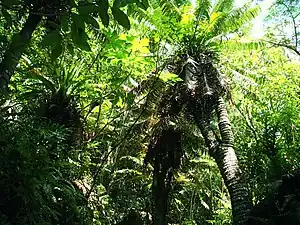 Understory habitation
Understory habitation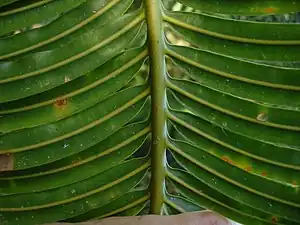 Pinnate leaf formation
Pinnate leaf formation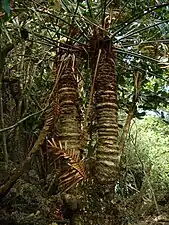 Stem and palm-like structure
Stem and palm-like structure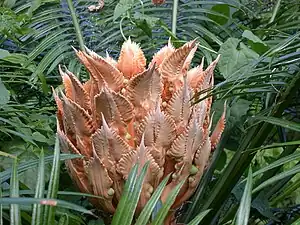 Female reproductive structures (megasporangia)
Female reproductive structures (megasporangia)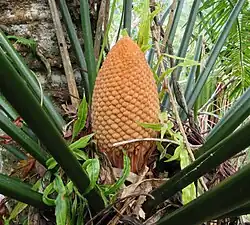 Male cones (microsporangia)
Male cones (microsporangia)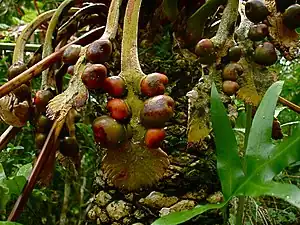 Fertilized megasporangia with developing seeds
Fertilized megasporangia with developing seeds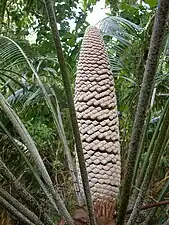 Infestation by the armored scale on the male cone
Infestation by the armored scale on the male cone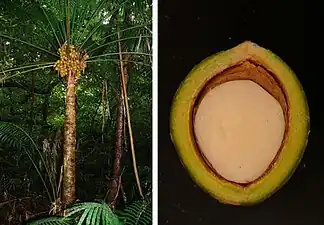 Developed seed
Developed seed
See also
References
- 1 2 3 Bösenberg, J.D. (2022). "Cycas micronesica". IUCN Red List of Threatened Species. 2022: e.T61316A68906033. doi:10.2305/IUCN.UK.2022-1.RLTS.T61316A68906033.en. Retrieved 22 August 2023.
- ↑ Hill, K.D. (1994). Cycas micronesica. Australian Systematic Botany 7: 554-556.
- ↑ Athens, J., & Ward, J. (2004). Holocene vegetation, savanna origins and human settlement of Guam. Records Of The Australian Museum, 15-30.
- ↑ Sacks, Oliver. (1996). The Island of the Colour-blind. Pan Macmillan Australia: Sydney. ISBN 0-330-35887-1
- ↑ Cox PA, Banack SA, Murch SJ, Rasmussen U, Tien G, Bidigare RR, Metcalf JS, Morrison LF, Codd GA, Bergman B (2005). "Diverse taxa of cyanobacteria produce b-N-methylamino-L-alanine, a neurotoxic amino acid". PNAS. 102 (14): 5074–5078. Bibcode:2005PNAS..102.5074C. doi:10.1073/pnas.0501526102. PMC 555964. PMID 15809446.
- ↑ Esterhuizen M, Downing TG (2008). "β-N-methylamino-L-alanine (BMAA) in novel South African cyanobacterial isolates". Ecotoxicology and Environmental Safety. 71 (2): 309–313. doi:10.1016/j.ecoenv.2008.04.010. PMID 18538391.
- ↑ Vogt, S., & Williams, L. (2004). Common flora & fauna of the Mariana Islands. Saipan?: S.R. Vogt & L.L. Williams.
- 1 2 Hill KD (1994). "The Cycas rumphii complex (Cycadaceae) in New Guinea and the western Pacific". Australian Systematic Botany. 7 (6): 543–567. doi:10.1071/sb9940543. ISSN 1446-5701.
- ↑ Willis, K., & McElwain, J. C. (2014). The evolution of plants (2nd ed.). Oxford, United Kingdom; New York: Oxford University Press.
- ↑ Terry, Irene; & Marler, Thomas. (2005). Paradise Lost? Tipping the scales against Guam’s Cycas micronesica. The Cycad Newsletter 28(3-4): 21-23.
- ↑ Donnegan, J., & Pacific Northwest Research Station. (2004). Guam's forest resources, 2002 (Resource bulletin PNW ; 243). Portland, OR: U.S. Dept. of Agriculture, Forest Service, Pacific Northwest Research Station.
- ↑ Marler, T.E.; Lawrence, J.H. (2012). "Demography of Cycas micronesica on Guam following introduction of the armoured scale Aulacaspis yasumatsui". Journal of Tropical Ecology. 28 (3): 233–242. doi:10.1017/S0266467412000119.
- ↑ Marler, T.E. (2010). "Cycad mutualist offers more than pollen transport". American Journal of Botany. 97 (5): 841–845. JSTOR 20700414.
- ↑ Marler, T.E.; Miller, R.; Moore, A. (2013). "Vertical Stratification of Predation on Aulacaspis yasumatsui Infesting Cycas micronesica Seedlings". HortScience. 48 (1): 60–62. doi:10.21273/HORTSCI.48.1.60.
- 1 2 "Redlist - Cycas micronesica".
External links
- The Cycad Pages – Cycas micronesica Archived 2014-06-23 at the Wayback Machine
- Plants of Guam [Botanical]- University of Guam College of Natural Arts and Sciences
- Flickr: Plants of Guam by Lauren Gutierrez - Cycas micronesica K.D. Hill
- Guam Plant Extinction Prevention Program
"Home". Guam Plant Extinction Prevention Program. Retrieved 2018-06-08.
